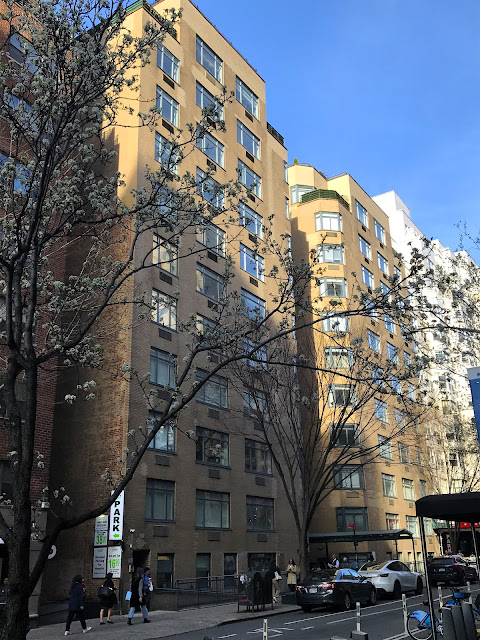Bronx natives, brothers Sidney R. and Arthur W. Diamond both held law degrees from Columbia University. But they turned their focus to real estate, becoming major players in the erection and management of apartment buildings.
In 1939, the Diamonds hired the architectural firm of Boak & Paris to design a 10-story-and-penthouse apartment building on the site of four vintage brownstones at 166 through 172 East 77th Street between Third and Lexington Avenues. Clad in beige brick, it was completed the following year. Typical of Boak & Paris's designs, the central portion was recessed, allowing for dramatic chamfered corner windows.
Potential residents could choose apartments of 3, 3-1/2 or 4 rooms with one or two baths. A brochure boasted, "unusually large rooms, dropped living rooms, dinettes, glass-enclosed stall showers" and "modern steel casement windows specially equipped with fresh air ventilators." A modern amenity was the "radio outlet in each living room."
Each of the six penthouse apartments had a terrace. On June 22, 1940, The New York Times reported that Arthur David, president of Edward Davis, Inc., meat dealers, had taken a penthouse "which is to be built to his specification by Sidney and Arthur Diamond." The article noted, "the house is nearing completion."
Four months later, William H. B. Cooper and his wife, the former Gertrude Cooper, leased the last penthouse. At the time, The New York Times reported that the building was 95 per cent rented. Cooper was the son of Senator Charles Cooper. He and Gertrude had been prominent in Brooklyn society before moving to Manhattan, and owned a summer home in Hempstead, Long Island.
Living here at mid-century were insurance agent James L. Feder, his wife, the former Irma Rosenberger, and their daughter Jane. Jane had attended the Riverdale Country School before entering Wellesley College.
Theodore C. Garfiel and his wife lived here by the early 1960s. Born on May 1, 1905, Garfiel graduated from Columbia in 1924 and remained highly involved in the school's alumni activities. From 1962 to 1964 he served as vice chairman of the board of the Association of the Alumni of Columbia College, and in 1964 was elected president of the association and chairman of the board.
Resident Daniel Greenberg was the only patron in the Golden Goose Bar and Restaurant on West 23rd Street at 10:30 on the morning of February 9, 1971 when a gas explosion tore through the building. The New York Times reported, "The blast ripped out almost all of the roof of the 20-by-100-f0ot one-story structure, shattered the masonry floor and blew out the windows." The shock of the explosion broke windows on both sides of the little structure and across the street.
Amazingly, no one was killed. Five employees were rescued by firefighters. One of them, waitress Marie Colocrai, was pinned under a table under a pile of debris. All but one were admitted to Bellevue Hospital. Daniel Greenberg escaped with head injuries and cuts.
Living in a fifth-floor apartment at the time were Frank and Mildred Knight. During the 1930s and '40s, Knight was a well-known radio personality, the announcer for the Longines sponsored Symphonette, a weekly program of light classical music, and its Choraliers program. In the 1950s he was the announcer of the Columbia Broadcasting System's television program Chronoscope.
Born in St. John's, Newfoundland, Knight served with the Royal Newfoundland Regiment during World War I, and studied medicine at McGill University before turning to acting. He landed several Broadway roles, but discovered his voice was best suited to radio. He first worked as a news reporter in 1926.
In 1952, The New York Times television editor Jack Gould said that Knight delivered his commercials "with an almost cathedral formality. They tend to induce such a feeling of social inadequacy that a viewer might be forgiven if he found himself wondering whether he was really eligible to buy the product."
In 1970, Knight teamed with Jack Benny to narrate the recording The Golden Age of Radio, produced by the Longines Symphonette Society.
At around 9:45 on the evening of October 9, 1973, a fire broke out in the Knights' bedroom. Mildred, who was 77 years old, had been bedridden for several years. Knight, who was two years older, was unable to get her out of the apartment as the fire spread. She was burned to death and Knight seriously injured. The fire was confined to the couple's apartment.
Ten days later, The New York Times reported, "Frank Knight, who was a radio and television personality in the days of Graham McNamee, Ted Husing and Kate Smith, died yesterday at the Lenox Hill Hospital.
Known today as Diamond House, at some point its multi-paned casement windows, so important to the Boak & Paris design, were replaced.
many thanks to reader Lowell Cochran for suggesting this post
photographs by the author
no permission to reuse the content of this blog has been granted to LaptrinhX.com






.png)
Author Diamond replaced the windows in the 90s here and 177 and this one got a whole building reno for the condo conversion. The greater tragedy is that it lost its original lobby unlike 177.
ReplyDelete